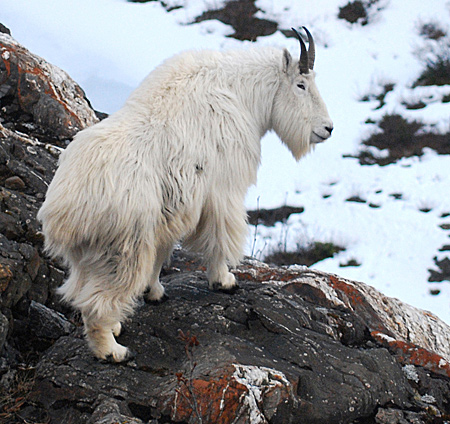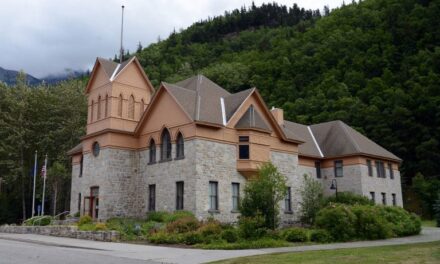
A new Fish and Game study delineates probable winter goat habitat in the Chilkat Valley. (Alaska Department of Fish and Game)
At meeting Tuesday, the Haines Assembly indicated that it wants to prioritize wildlife conservation in heliski map decisions. The assembly is working to establish a new process to vet heliski map amendment requests. One major question is how much weight will be given to new studies of wildlife habitat that sometimes overlaps with ski terrain.
There’s one line in the heliski map ordinance that’s caused the most debate so far.
It says borough staff will superimpose recommendations from the Northern Wild Sheep and Goat Council on the ski area map. The goat council is a professional organization made up of wildlife biologists. The group reviews research and makes recommendations on how to limit human impacts on wild sheep and goats.
One of its main recommendations is that there should be a 1500-meter buffer between helicopter activity and goat habitat. If the buffer is diminished, the helicopter noise can negatively affect the animals.
The ordinance in front of the assembly Tuesday night crossed out the line about the goat council recommendation. The suggestion to get rid of that sentence came from a meeting between two advisory committees. The tourism advisory board and parks and recreation committee were fairly split on the issue. The vote was 6-5 to remove the goat council language.
“We should have more information rather than less information,” said Joe Ordonez. “This is critical information.”
Ordonez was one of a handful of residents who spoke in favor of reinstating the line about goat council recommendations.
“ADF&G already considers those,” said heliski company owner Scott Sundberg. “It’s redundant. It’s pointless.”
Sundberg said it wasn’t necessary, because the Alaska Department of Fish and Game will use the goat council standards in its recommendations to the borough.
Although the debate centered on the goat council, it is Fish and Game that recently released studies on Haines-area mountain goat and brown bear habitat.
Biologists now have a formula to determine whether a certain mountain face is likely to be critical goat or bear denning habitat.
Sundberg said if you were to apply the 1500-meter buffer to all of the habitat area, it would knock out 50 to 70 percent of the heliski terrain.
“We often hear ‘critical goat habitat.’ The map that was produced was potential mountain goat habitat,” Sundberg said. “I want you to remember when you’re thinking about this, it’s not just everywhere.”
Kevin White is the Fish and Game biologist who led the goat habitat study. He confirmed to KHNS that Fish and Game uses the goat council information in its heliski map input.
But he said he supports the borough committing to use the goat council recommendations in its map review.
And so do most of the assembly members.
“It seems to me that we don’t lose anything by incorporating the Northern Wild Goat and Sheep Council recommendations,” Assemblyman Tom Morphet said. “It’s more information, it’s a scientific group.”
The assembly voted 5-1 to reinstate the line about goat council recommendations. Brenda Josephson was opposed.
As the discussion wrapped up, Assembly member Sean Maidy tried to reassure heliski operators.
“The way I see it is we know what parts to avoid, but there’s still lots of space we can work together to get a good plan for a good tour and a good permit to continue with the industry,” Maidy said.
The heliski map ordinance has one more public hearing scheduled. But if it’s approved, the borough won’t follow the new process for a few years.
That’s because it’s already in the middle of evaluating the most recent map amendment requests. The review was put on hold earlier this year. The borough was waiting for the wildlife studies and dealing with conflict of interest complaints about the map committee.
Borough planner Holly Smith says the assembly will take up the pending map requests at a meeting in the upcoming weeks. It will be the first test of how the assembly will reconcile industry interests with the new goat and bear habitat information.








